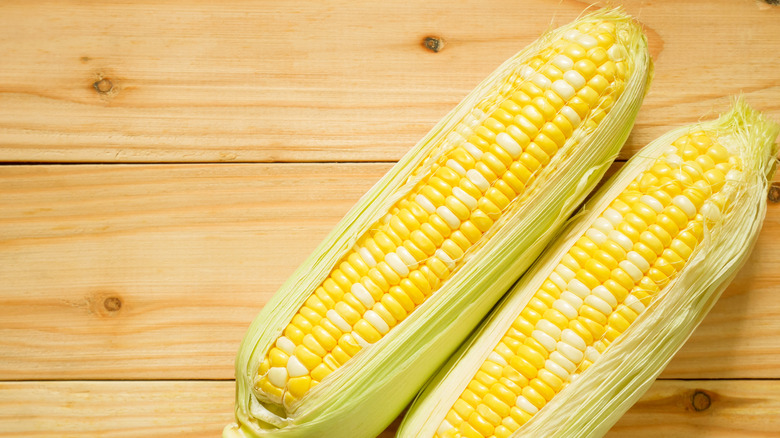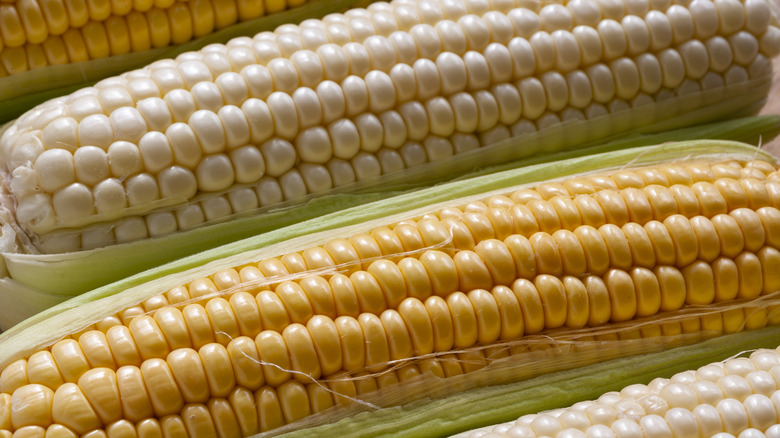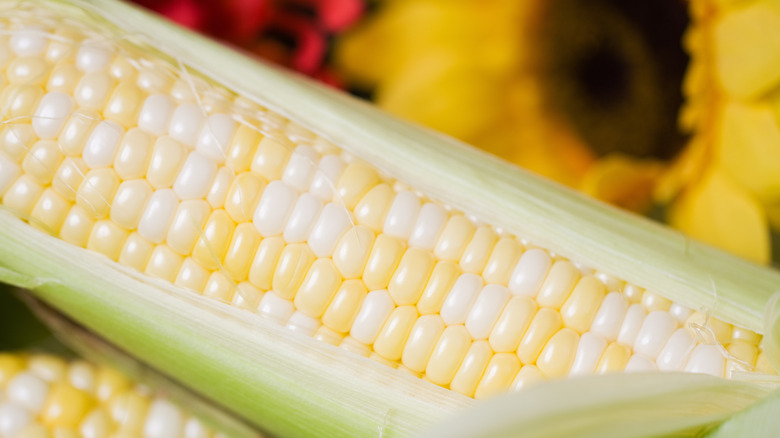The Main Differences Between White And Yellow Corn
Corn is one of the most basic food staples on the planet, a fact that undermines how immensely complex the food actually is. Corn is simultaneously classified as a fruit, vegetable, and grain, and its breeding by native Mexicans around 9,000 years ago represents one of the first genetically modified organisms humans ever grew. In the millennia since that era, humans have developed a vast array of corn varieties notable for the dazzling range of colors they come in. There's deep blue, ruby red, jet black, and even multicolored corn, but you wouldn't know any of that going off the selection in a grocery store. When it comes to the corn that we eat on a regular basis, there are really only two main options: white or yellow.
When we eat corn on the cob, we're specifically eating sweet corn. Sweet corn may be white, yellow, or bi-color with kernels of both hues. Many people say that yellow kernels are sweeter than white ones and insist you should always choose yellow corn for the best flavor, but this is a complete myth. The color of sweet corn has nothing to do with its flavor. There are really only two differences between white and yellow corn. The first is color, obviously, but on top of that, there is a slight nutritional difference. The pigment present in yellow corn does enhance its vitamin content. However, the difference is typically quite minimal. For general purposes, the choice between white and yellow corn is inconsequential.
What causes corn to be white or yellow?
Indigenous Americans developed different types of corn that were each suited to different purposes: Sweet corn for eating, popcorn for popping, and flint corn for grinding into cornmeal. Different varieties came in different colors, and the natives gave spiritual significance to each hue. The first version of sweet corn had white kernels, but at some point, a genetic mutation occurred. Some corn kernels developed chemicals called carotenoids that gave them a yellow pigment. At first, yellow corn was only used for animal feed, but in the late 1800s, a farmer in Massachusetts named William Chambers bred a carotenoid-rich variety of sweet corn that ripened remarkably quickly. After he died, his collection of seeds was sold to W. Atlee Burpee, thecreator of iceberg lettuce, who marketed it under the name Golden Bantam.
The key carotenoid in yellow sweet corn is beta-carotene, an antioxidant that our bodies convert into vitamin A. Vitamin A, or retinol, is very important for preserving a healthy immune system, skin, and mucous membranes, but it is perhaps most known for contributing to eye health, according to Healthline. Large doses of vitamin A can actually be toxic, but fortunately, our bodies stop converting beta-carotene into vitamin A once they have enough. Thus, getting vitamin A from foods like yellow corn is considered safer than taking supplements. Most commercially sold yellow corn only has a little bit of beta-carotene, but some varieties have so much that they are being studied for medical purposes.
If color doesn't affect corn's flavor, what does?
The nutritional advantage of yellow corn over white is generally minimal unless you find one of those rare varieties with ultra-high beta-carotene. As such, the main difference between these two types of corn is color alone. There's a misconception among some people that yellow corn is sweeter, but in truth, yellow, white, and bi-color corn can all be just as sweet. Sometimes, you will find cobs of yellow or white corn that don't taste as sweet, but this isn't about pigment.
Up until the 1800s, sweet corn wasn't even that sweet. That's because it would lose around half of its sweetness after being picked. In a quest for sweeter corn, farmers began cross-breeding different corn varieties to give them higher and higher amounts of sugar. This resulted in the three types of sweet corn that exist today: normal sugary, sugar-enhanced, and supersweet. Sugar-enhanced corn has twice as much sugar as the normal sugary kind, and supersweet corn has three times as much. Supersweet corn also has a longer shelf life, lasting up to one week.
Most of the sweet corn sold in the United States today is of the supersweet variety. It doesn't matter whether the corn you purchase is white, yellow, or bi-color because it's almost certainly going to be super sweet corn regardless. The main factor affecting which color you buy is going to be where you live. For example, yellow corn is more prevalent in New England, while white corn dominates California.


